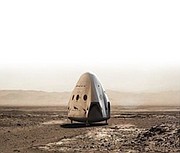ELON Musk, the billionaire founder and chief executive of SpaceX, plans to send a Dragon capsule to land on Mars as early as 2018 - a big first step toward his ultimate goal of colonising the ‘red planet’.
The Mars spacecraft will be called Red Dragon, Mr Musk said in his announcement last week. No astronauts will accompany Red Dragon on this first test flight.
Mr Musk said he wouldn’t recommend transporting crews in Dragons beyond the moon; its internal volume is only about the size of an SUV.
California-based SpaceX already is using Dragons for space station supply runs, and the company could start flying Americans to the International Space Station by the end of next year.
Mr Musk said the upgraded Dragon is designed to land anywhere in the solar system. The propulsive landing system was tested recently at the SpaceX plant in McGregor, Texas.
Red Dragon would be launched aboard a mightier version of the current SpaceX Falcon rocket that may make its debut at Florida’s Kennedy Space Center by year’s end.
After successfully landing a leftover Falcon booster at sea earlier this month, Mr Musk said he would elaborate on his approach to establishing a city on Mars at an aerospace meeting in Mexico in September.
He maintains that re-using rockets is key to reducing launch costs and, consequently, opening up space. SpaceX now has managed to land a first-stage booster on land, as well as on an ocean platform. The recently retrieved booster could fly again on another satellite mission this summer.
NASA, meanwhile, has its own Mars exploration programme, intended to send astronauts there in the 2030s. The space agency contracted out station deliveries in the post-shuttle era in order to focus on that long-term goal.
Shortly after the SpaceX announcement, NASA’s deputy administrator, Dava Newman, said the space agency will offer technical support to Mr Musk’s company in exchange for Red Dragon descent and landing data from Mars. No money will be exchanged, she stressed.
The window to embark on a Mars mission, whether robotic or human, comes only every two years because of planetary alignment.





Comments
Use the comment form below to begin a discussion about this content.
Sign in to comment
Or login with:
OpenID